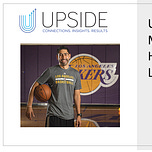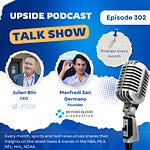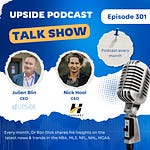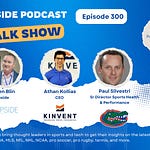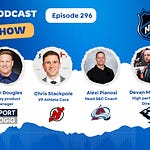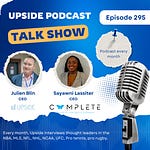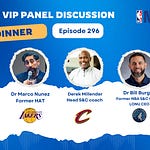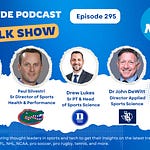This week we had the honor to interview Marco Nunez, the former Head Athletic Trainer for the LA Lakers (NBA). Marco worked for the LA Lakers for 8 years.
📝 Show Notes: Through this interview, we touched on his background, the role that he played at the LA Lakers, the impact of COVID 19, his favorite technologies, and what made Kobe Bryant, who he worked with, so special.
Best Quotes: Here’s some of the key discussion points and best quotes from our conversation with Marco:
On his background: “ I went to school specifically to become an athletic trainer, and to work in sports medicine. While I was in college, I had the desire of trying to work in the professional setting. That's where I wanted to pursue my career and hopefully end up there. I started and had the great opportunity to work with the LA Avengers. They were a small arena football team out here in LA. I worked with them for about four years. So slowly I worked my way up. Eventually, I spent four years as an assistant athletic trainer with the LA Avengers, then I got hired as the head athletic trainer with the Carolina Cobras out in Charlotte, North Carolina. I did that for one year. I came back to Southern California and I got hired as the head athletic trainer for the Los Angeles Sparks, a WNBA team. I think that was a huge opportunity for me because at the time the Sparks were owned by the LA Lakers which was owned by Dr. Jerry Buss. Now, if you don't know, Dr. Jerry Buss was also the owner of the LA Lakers”.
On how he ended up working for the LA Lakers: “The LA Sparks, our facility, our locker room, and our training room was directly across the hallway from the LA Lakers. So I had the opportunity to meet Gary Vitti, the head athletic trainer for the LA Lakers. I also had the opportunity to meet the rest of the staff and slowly by slowly I joined them. I was working as an intern during the summer with them. Whenever the team would leave, and when there was a player that was behind injured, they would give me the responsibility to continue their rehab while they were traveling. Eventually the Lakers also purchased a development team called the LA D-Fenders. They are currently called the South Bay Lakers. I got hired for that position as a head athletic trainer. So I got to work even more closely with the LA Lakers teams. Eventually a position opened up with the LA Lakers as the assistant athletic trainer / assistant rehab specialist / assistant strength and conditioning coach, strength condition specialist. And I got hired for that position. I did that for about eight years and then eventually Gary Vitti, the head athletic, retired. And I was promoted to head performance athletic trainer for my last three or four years with the organization”.
On the biggest challenges he faced as the head athletic trainer for the LA Lakers: “I was excited when I was offered the position and I was looking forward to it. As a young athletic trainer, when I first started out, I wanted to have the challenge of working with a huge organization. And besides the Dallas Cowboys or the New York Yankees, you can't get anything bigger than the LA Lakers. They are in the spotlight. Not only that, but the previous head athletic trainer Gary Vitti had been in that seat for 32 years, which was a long time. So those were some huge shoes for me to fill. So as excited as I was, I was also nervous at the same time. And butterflies were going, but I felt I was ready. I felt I was prepared for it after eight years observing how he operated and how the organization operated and how they went on. So I guess one of my big first challenges was just to fill those shoes from Gary Vitti”.
On establishing his own philosophy as the new head athletic trainer: “I wanted to establish my own self and my own philosophy with the organization, as far as the sports medicine aspect. The other thing that I also wanted to introduce was, and I know from the years I spend previously with the Lakers, that we didn't have much of a sports science technology. We didn't do much data analytics, and I wanted to slowly start introducing some new tactics in that area within the organization, such as biometrics, force plate testing, or anything like that. But at the same time, I knew that I couldn't just go in there my first year, my second year and just start like, Hey, let's do everything. There are a lot of things. So I wanted to slowly progress through some things, and more importantly, make sure that the athletes were receptive to it. Because at the end of the day, if the athletes are not receptive to whatever technology you're using, whatever you're tracking, whatever biometrics you're using, it doesn't matter how good that technology is. It doesn't matter how good that and data is, if the athletes aren't cooperative, and they're not receptive to it, it means nothing”.
On the type of technologies he would build if he had unlimited resources: “So the first one that pops in my head would have to be, and I'm just thinking about the NBA right now, would be that the ground or the whole entire floor would be a force plate. So the idea would be to track the athlete’s movements. Now you would have to take a step further, because then now you're going to have to be able to have a camera system that links with each player and identifies each player. And every time they take a step from the right leg and left leg, you would be able to distinguish their force between the right left, and how much movement they produce. The third one would be being able to analyze some muscular output while they're making those movements to try to see where are the discrepancies are, and where the movements are. And one of the things that I've always done, and we always do t-tests, we do four corner tests, and it's always based on time. So when an athlete does a four corner test, they go up to a cone, make a turn, turn, turn, come right back. And it's always based on time, and about seeing how fast the player can go”.
On the day Kobe Bryant, who he worked with, passed away: “So I believe it was a weekend. It was on a Sunday. I think I was in my backyard. That day it was very cloudy, and overcast. The sun wasn't even peeking out. I mean, that's how heavy the clouds were. I remember that day. And I was in my backyard and all of a sudden I get a text from a friend of mine and he says: “Is it true?” And I'm like, what do you mean is it true? I wasn't listening to the news. I wasn't listening to the radio. I was just outside. I think I was doing gardening. And I'm like: “Well, what do you mean? What's true?”. And then he texts, Kobe. I'm like: “What?” And then he sends me the TMZ link. And I'm like, no, this can't be real. Right? TMZ is probably fake news. Now, granted TMZ is pretty reliable, but I'm like, no, it's nothing. So I waited, and then more people texted me. It's like, Marco, is this true? Marco, what have you heard? So then once more people start texting, I'm like, okay, what's going on? So I go in, I turn on the news, but they still hadn't reported anything yet. I waited, I waited. And Maybe about 30 minutes into it, I see ABC News started reporting it. NBC News started reporting it. And then at that point I'm like, okay, this is real”.
On why it was hard for him to accept Kobe Bryant’s passing: “It was hard to believe that it happened because Kobe had this persona of being invincible and indestructible. That's like how, when you meet him, and you're around him, you believe that the dude is like Wolverine, and nothing's going to happen. He goes out there and he does his thing. He's just like this, he's a machine. It's like the movie with Rocky, Rocky four and he's a machine and you can't beat him. That's who Kobe was. And for him, for something like this, for him to go down, it was something that was very hard for me to believe. And it's still hard for me to believe that he passed away like that. But, it was tough. And after that, it took me a little while to finally come to cope with it, because I worked with him for about nine years. I was with him starting in '08 where we went off to Boston. We won the two championships and then eventually his final game at STAPLES Center. And he finally retired. But even then you kind and see that he probably still had a couple more years in him, but he was like, no, I think I'm done. Out of all the other people, I think he could have been the Tom Brady of the NBA”.
On Kobe Bryant’s mamba mentality: “And a lot of people didn't quite understand what that means. And it's one of those things where the Mamba mentality is about being mentally tough and doing your job and so to speak. The one thing about him also is that he expected everybody to bring their A game. And when I say everybody, I'm referring to everybody. Not just the players, not just the coaches, he expected the training staff, the sports medicine staff to bring their A game. And the equipment manager to bring the A game. The front office people, the ticket people, everybody was part of this. And he expected everybody to do the exact same thing, and to do their job. And not only that, but maybe sometimes you have to go beyond doing your job”.
On how he experienced Lobe Bryant’s mamba mentality one day: “I'll tell you a story. My very first year with him, we traveled to Denver. And this is where I kind of quickly realized what he meant as far as the Mamba mentality, and what you had to do, as myself, as an athletic trainer. As part of the crew I had to do my job. So we get to Denver and we had the game the next day. So we land there in the evening. He goes to the arena to just go get some shots up. He comes back. And we get a call from his security guard and says, “Hey Kobe wants a cold tub”. And I'm like, well, we are in the hotel room. We don't travel with a cold tub up. I'm like: dude where do you want me to get the cold tub? You know, this is my first year. That was my first reaction. Kobe was in the background and I think he could hear myself and the security guard just talking back and forth, and not necessarily arguing, but “dude what do you want to do?” You know, we don't travel. All of a sudden I hear Kobe's voice. He's like, I don't want to know how rough the waters are. Just tell me when the boat gets in, and he hang up. And that's when I realized, I got to bring my A game. I got to do my job. You can't take no for an answer. So our strength coach, Tim DiFrancesco was good friend with a young lady that was a trainer who was friend with a trainer at the university of Denver. So he called her up and she helped us out. He goes down there and gets him the cold tub and we got the job done. But that was like the Mamba mentality kind of going there”.
On Kobe Bryant’s philosophy to face challenges up front: “There's a book out there that I read. It is “Obstacles Is The Way”. I think, or the ways is the obstacle, meaning that whenever you have an obstacle, the way through it is through the obstacle. So in the book, it starts the story. And it starts about a story about a king who has his kingdom. And what he does, he puts his big folder in the center of the castle where you go in and out. And he blocks the entryway. Now you can do three things. One, some people were like, we're stuck here. We can't go anywhere. We're done. Second. You're like, okay, well, let's figure out, let's go around it. Let's climb it, let's go around it. Maybe let's open a new entryway. Let's find a different way. Or the third way is you just go right through it. And that was kind of Kobe's, the Mamba mentality. He always had obstacles in his way and he knew he had to go right through it. He didn't go around it. He didn't shy away from it. He went straight at it. Just like in the competition, whenever we had games, whoever it was, he didn't try to find a different way to go around. He went right through the obstacle type of thing. And that was like the Mamba mentality”.
On Kobe’s willingness to beat the Super teams: “Yeah. Well, here's a funny part about it. Not only did he not shy away from the challenge, but he wanted the challenge. He wanted the challenge and he had the same mentality as Michael Jordan. I think that's why both of them are very alike. And I don't think you're going to find anybody else that compares to both Kobe and Michael. And I remember Michael had made a comment, even Kobe made a comment one time in the training room about. There was a whole talk about how teams, how players team up to try to win games, stuff like that. I'm going to go team up with him so we can have a better squad, stuff like that. I remember that Kobe was like, “No, why am I going to team up with somebody like that? I want to beat them. I don't want to team up with them. I want to beat him”. And I remember Michael having the same mentality. That's how Kobe was, it was his mental, I don't want to team up with so and so, I want to beat him. That's how he was. He saw the challenge and he wanted go straight to the challenge”.
🔥Upside Chat: Alexi Pianosi, Strengths and Conditioning Coach, Pittsburgh Penguins (NHL)
🔥Upside Chat: Pierre Barrieu, High Performance Director, Toronto FC (MLS)
🔥Upside Chat: Len Zaichkowsky, World-Class’ Sports Biofeedback Expert

